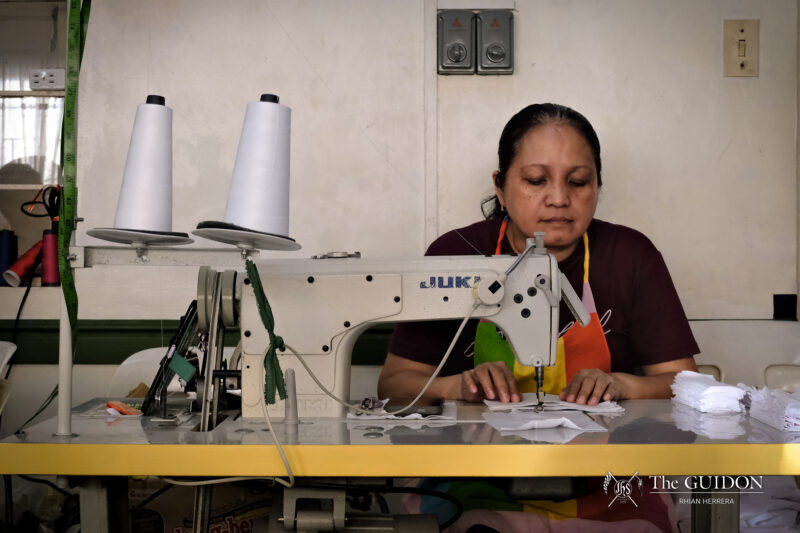MORNINGS IN the Philippines are often associated with the scent of freshly baked pan de sal. With its distinct taste, smell, and affordability, it’s no wonder that customers do what they can to snag a warm bag of pan de sal from local bakeries; once you’ve secured your fix, though, it becomes easy to forget what happens to the bakeries’ unsold products after they put up their “Sorry, we’re closed” signs.
Leftovers at the end of the day are inevitable, even for in demand staples like bread. Before looking into how the Filipino favorite contributes food waste, a concern that currently plagues the country, we must first delve into the phenomena’s local beginnings.
Food for thought
A lot can be said about how much we love Filipino food. History Department Professor Kristine Santos points out how typical Filipino meals have rice as a staple; it’s usually the ulam or viand that switches up, and we try to have a different one per meal. “I think our food culture is very vibrant, and it’s very abundant, even amongst the most meager of dishes,” she says. “Our food culture celebrates our abundance in terms of agriculture.”
She goes on to talk about how Filipino food culture can be reflected by our love for fiestas and our trends in consumption. According to Santos, Filipinos enjoy fiestas because of its buffet aspect, where one has “free will to get as much as you want.” Santos says that when Filipinos have to think of a good meal, their minds often go straight to big food gatherings that Filipinos often have.
When it comes to how Filipino consumption practices have changed over time, Santos expresses worry over how dependent Filipinos are on protein. “Regardless of where you go in terms of the humblest of carinderia to the fanciest of restaurants, more often than not you’ll find limited options in terms of vegetables but you’ll always have lots of options in terms of protein,” she laments.
Santos calls the issue of limited vegetable options interesting, possibly because of what it reflects about our diets. The Food and Nutrition Research Institute (FNRI) presented in February 2018 that Filipinos’ combined per capita consumption of fruits and vegetables is less than half of what is recommended by the World Health Organization; in contrast, Filipino consumption of meat and eggs have gone up. As the Filipino palate changes, it’s worth looking into how much the issue of food waste has changed along with it.
In a report by the Asia-Pacific Economic Cooperation (APEC) in 2015, it was found that 33% of the Philippines’ total food production goes to waste; in contrast, a 2018 World Hunger Report reflects that there are nearly 14.2 million undernourished Filipinos and 13.3 million Filipinos who identify as “food-insecure.” Statistics show that Filipinos annually waste an average of 3.29 kg per year, which could feed an estimated 4.3 million Filipinos if needed. The disparity shows that despite the abundance we so often celebrate, much of our meals still get trashed at the end of the day.
Our daily bread
As we re-evaluate our disposal practices, it’s worth looking into what we do with our bread. Historically, bread has served to augment hunger in low-income families. Santos notes how the pan de sal, in particular, came to be a Filipino favorite.“[For] those who want to have a taste of bread—something that’s easy or accessible—[it] would have been the cheapest bread you could buy,” she says.
Today, commercial bakeries make up 20.3% of the 3,000 manufacturing establishments in the country. Along with its historical ties, bread has evolved into a dietary staple in the Philippines; eaten out of convenience as an alternative for rice or as a snack. With this, bakeries have to ensure that the bread they sell is being presented as something filling yet ready to eat immediately.
As commercial bakeries expand, though, so too does the problem of waste. There are various reasons why commercial bakeries prioritize selling fresh bread daily and dispose of unsold bread, one of which is edibility. Santos notes that as stored bread is exposed to humid environments, it becomes prone to developing mold or hard texture.
Meanwhile, other bakeries are concerned about ensuring profit and maintaining the legacy of the bakery’s brand. Jan,* an officer who is in charge of a local commercial bakery that branches from a supermarket owned by a Filipino multi-millionaire, shares that daily bread disposal is practiced on the daily. Jan adds that unsold breads were directly thrown into the trash bins with powdered soap on it to ensure that disposed products would not be re-sold or taken from the trash.
Santos emphasizes that bakeries are businesses that “respond to their community. If the community cannot even afford [bread], then there’s a great likelihood that [the bakery] will close.” Thus, bakeries must learn to adapt to consumers’ consumption patterns while leaving minimal bread waste at the end of the day.
Sharing the loaf
Not all bakeries prioritize profit at the cost of food waste; one such example would be the closing time sales, where bakeries markdown the prices of their pastries before the end of the day. Santos notes that, among the commercial bakeries, The French Baker was among the first to adopt this practice.
Today, other bakeries have found innovative methods to sell unsold bread and reduce food waste. Butcher’s Cafe Katipunan Store Supervisor Dianne Rubi says that in the scenario that the bread on sale still does not get sold, the bread would be repurposed to produce other goods. “Usually ang hindi nasosold is pan de sal, so yung pan de sal ginagawa namin siyang buttered pudding,” she adds.
(Usually, pan de sal does not get sold out, so we turn them into buttered pudding.)
With the issue of food waste at hand, the House of Representatives has recently approved House Bill 8873, also known as the “Food Reduction Act,” which requires food establishments to donate leftovers and mandates the creation and regulation of food banks. This bill aims to pave the way for further involvement of companies and charities in tackling the issue of hunger while reducing food waste due to leftover food.
Therefore, there is a need for commercial bakeries to explore initiatives beyond sales in order to lessen food waste. These could include engaging in charitable causes to solve the societal problem of hunger. Notable efforts include the ReFood project in Portugal wherein volunteers collect leftover food from food establishments to provide for the poor in their community.
The practice of donating leftover food–not limited to bread–to charity is already being done locally to some extent. Santos recalls her experience working for an international coffee chain: “[One] of the things [that the owners] told [employees] is that, at the end of the day, put the bread together and…donate it to the nearest charity.”
Molding new practices
Despite the difficulties bakeries face in ensuring zero food waste and maintaining product quality, bread continues to play an important role in forming Philippine culture and society as it adjusts to their social and economic needs and stature. While bakeries value customer satisfaction and profit, there is more at stake to be considered with every slice of bread.
Food waste is definitely not limited to our commercial bakeries; the phenomenon is one that exists on a more macro scale, within the contexts of both the consumer and the producer. Whether it stems from the food we end up wasting at full-spread buffets or the perishables products that bigger enterprises purchase, the concern of food waste demands immediate preventive action.
“I think that throwing away unsold food is a signifier of lack of optimization within the establishment,” Vice President of Sustainability for the Management Engineering Association (MEA) Jericko Garcia (3 BS ME) says. “Aside from the fact that throwing away unsold food creates food waste, it also shows the inefficiency of the establishment in its production of goods.”
Garcia asserts that proper planning and optimization is a sustainable solution to our concerns with food waste; he adds that the root cause of the problem should be identified in order to craft holistic solutions.
While bakeries take a step towards eliminating waste and improving customer experience, more innovative and inclusive solutions are needed in order for everyone to enjoy a slice of freshly baked bread.
*Editor’s Note: The name of the interviewee has been changed at their request in order to protect their identity and privacy.







